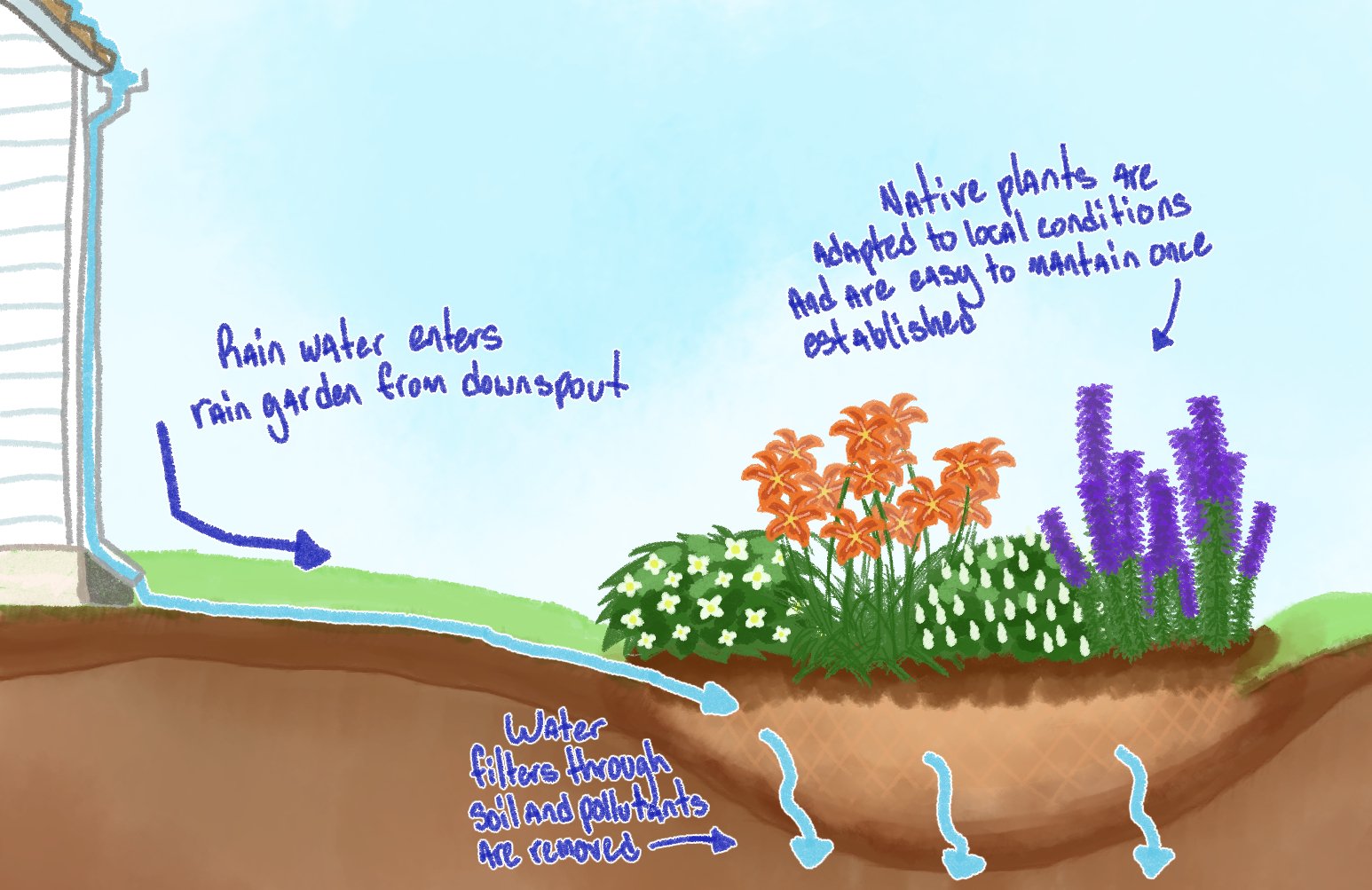Rye Rain Garden Program
(Some text here).
What is a rain Garden
A rain garden is a type of bioretention cell created to minimize the stormwater and runoff being absorbed into the land. They are small, sunken areas that are typically 100 to 300 square feet large, allowing them to be able to be implemented in anything ranging from house yards to nature centers. Rain water can be absorbed right where it falls, in addition to filtering runoff water.
BENEFITS
A rain garden can not only help your own house and land, but the entire ecosystem as well! Rain gardens help filter out pollutants such as trash, bacteria, animal feces, and other pollutants into water runways and spreading throughout the ecosystem. The storm-water falls through the filtered soil, sand, and/or gravel in the rain garden, where the clean water then exits through an output system.
“An effective way to address storm water on a private parcel basis, a rain garden is probably one of the easiest things you can do that makes a difference and that gives you a benefit as a homeowner”
Getting Started: The Basics
1. determine Location and shape
Because the rain garden needs runoff water to flow towards it, the garden should be located at a low point in one’s yard. Ideally, this would be right where downspouts also point. The rain garden should be at least 10 feet away from infrastructure as to avoid saturating soil close to its foundation. Decide on the shape preferred for your rain garden that can range from ovals, kidneys, teardrops, and rectangular shapes, and make the outline with spray paint.
2. Determine depth and size
The size and depth of a rain garden are largely dependent on the soil and how absorbent it is. The garden size should be calculated through estimating the surface area of the home roof and multiplied by 1 inch (of rainfall) to get the approximate rainfall volume during a 1-inch rain. Though this size is a general guideline, do not feel restricted by the number! Rain gardens can be both bigger or smaller if needed; bigger gardens can include more plants while also still helping manage rainfall while; a smaller garden is still effective, possibly even more than you might think! (A garden 70% smaller than ideal can catch about 75% of the water from such a storm.)
3. Plant Types
Choosing plants will depend on where they go in the rain garden. Plant on the outside edges of the rain garden with species suitable for drier conditions. Plants on the inner section of the rain garden must be able to tolerate both wet and dry conditions.
4. Maintaining your rain garden
The idea of maintaining a home rain garden may be daunting for some, but getting a better picture of the time and money budgeted for such may help ease the mind. Though rain gardens do require maintenance like any garden, the amount of labor decreases with time. Every garden is different and maintenance can depend on the plant species, size, and climate of the rain garden, but here is an overview of what might be expected:
Pruning (1-2 per year)
Pruning helps direct the growth of plants, which improves plant health and increases production of flowers. A rain garden is slightly different than the procedure for an ordinary garden in that dense shrub growth is encouraged. The shrubs help absorb, deflect and filter out water, which increases the filtering capacity of the rain garden. This can be done by removing lower branches fully or partially to create a denser shrub. Additionally, tattered and discolored plants should be “deadheaded” after spring in order to produce new succeeding growths.
Mowing (2-12 per year)
Mowing is necessary after growing season to remove stems and seedheads. String trimmer or mowers (with mowing deck raised to 6-8”) can be used to remove dead plant materials, and the former may be used to regulate over-competitive growths. Mowing should be done at least twice a year, as native graces should be cut after the first few weeks of early growth (early spring) and mid-may, but other areas may be mowed as deemed necessary.
Watering (2-7 per week initially, then sporadically)
Watering will generally be taken care of by the stormwater system of the rain garden, but additionally watering will be needed during the initial growth of the rain garden. The garden should be watered once every 2-4 days for the first 1-2 months, but then can be watered sporadically after.
Replanting (annually)
The survival rate of plants in a rain garden will increase with time; around 10% of plants will die the first year, will decrease annually. If there are any areas of exposed soil or are needing more protection, that section should be reseeded or built up, respectively. Any rocks diverting flow out of the garden should be replaced.
inlet/outlet inspection (1 after first rain, then monthly during rain season)
Accumulated sediment is a sign of success of the rain garden, as their very purpose is to direct that away from waterways. Carefully, avoiding plants, remove accumulated sediment with a flat shovel. Make sure that the sediment isn’t coming from the garden itself, as this can sometimes occur in early stages.
Related Posts
Rain Rain Garden LEADER
Sue Drouin (Chair)
Amy Kesavan













